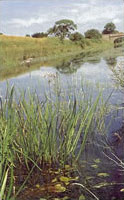Cannock Canal Extension
The Cannock Extension is a side branch of the Wyrley and Essington Canal extending northwards for 2.5km towards Norton Canes. It is part of the extensive inland waterway system running throughout Birmingham and the Black Country. The high water quality, uneven canal bottom and the low volume of boat traffic have allowed a diverse aquatic flora to develop without any extensive reedswamp incursion.
Flora and fauna
A total of thirty-four aquatic plants have been recorded from the canal, making it the richest known waterway of its type in Staffordshire and the West Midlands, and placing it high within the national canal network series.
Of major importance is a large population of the nationally scarce floating water-plantain (Luronium natans), the best known colony in both Staffordshire and the West Midlands. This plant, recognised as endangered in Europe, is found throughout the length of the Cannock Extension.
Other special designations
This site has also been designated a Special Area for Conservation (SAC) because of its European importance for this plant species. Good populations also exist of flowering rush (Butomus umbellatus), arrowhead (Sagittaria sagittifolia), shining pondweed (Potamogeton lucens), perfoliate pondweed (P. perfoliatus) and spiked water-milfoil (Myriophllum spicatum), all of which are rare of uncommon in Staffordshire. Other uncommon species present include curled pondweed (Potamogeton. crispus) and narrow-leaved water plantain (Alisma lanceolatum).
The eastern canal bank is brick-edged with several species including hemlock water dropwort (Oenanthe crocata), skullcap (Scutellaria galericulata), fairy flax (Linum catharticum) and water dock (Rumex hydrolapathum), growing out of the brickwork. The towpath itself supports such species as common spotted-orchid (Dactylorhiza fuschii) and greater bird's-foot-trefoil (Lotus uliginosus). The western bank is much more natural with reed sweet-grass (Glyceria maxima) and branched bur-reed (Sparganuim erectum) forming extensive marginal stands. Yellow iris (Iris pseudacorus) and yellow loosestrife (Lysimachia vulgaris) add to the diversity of this community.
At least nine species of dragonfly have been recorded in association with the canal, including the red-eyed damselfly (Erythromma najas) and emperor dragonfly (Anax imperator), the latter species being at the northern edge of its range in Britain.
The canal towpath is publically accessible throughout the length of this site.
